
Victorian architecture is a series of architectural revival styles in the mid-to-late 19th century. Victorian refers to the reign of Queen Victoria (1837–1901), called the Victorian era, during which period the styles known as Victorian were used in construction. However, many elements of what is typically termed "Victorian" architecture did not become popular until later in Victoria's reign, roughly from 1850 and later. The styles often included interpretations and eclectic revivals of historic styles (see Historicism). The name represents the British and French custom of naming architectural styles for a reigning monarch. Within this naming and classification scheme, it followed Georgian architecture and later Regency architecture and was succeeded by Edwardian architecture.
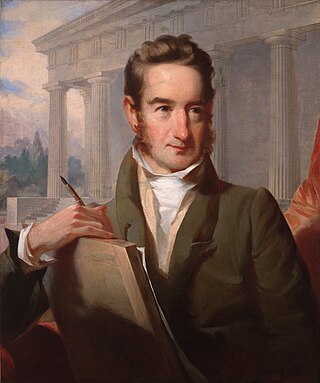
William Strickland was a noted architect and civil engineer in Philadelphia, Pennsylvania, and Nashville, Tennessee. A student of Benjamin Latrobe and mentor to Thomas Ustick Walter, Strickland helped establish the Greek Revival movement in the United States. A pioneering engineer, he wrote a seminal book on railroad construction, helped build several early American railroads, and designed the first ocean breakwater in the Western Hemisphere. He was elected as a member of the American Philosophical Society in 1820.

Center City includes the central business district and central neighborhoods of Philadelphia, Pennsylvania, United States. It comprises the area that made up the City of Philadelphia prior to the Act of Consolidation, 1854, which extended the city borders to be coterminous with Philadelphia County.

Old City is a neighborhood in Center City, Philadelphia, Pennsylvania, United States, near the Delaware River waterfront. It is home to Independence National Historical Park, a dense section of historic landmarks including Independence Hall, the Liberty Bell, the First Bank of the United States, the Second Bank of the United States, and Carpenters' Hall. It also includes historic streets such as Elfreth's Alley, dating back to 1703.
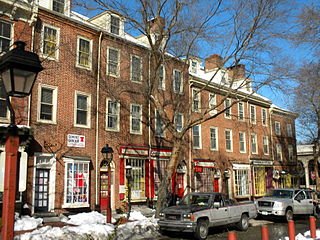
Society Hill is a historic neighborhood in Center City, Philadelphia, Pennsylvania, United States, with a population of 6,215 as of the 2010 United States Census. Settled in the early 1680s, Society Hill is one of the oldest residential neighborhoods in Philadelphia. After urban decay developed between the late 19th and early 20th centuries, an urban renewal program began in the 1950s, restoring the area and its many historic buildings. Society Hill has since become one of the most expensive neighborhoods with the highest average income and second-highest real estate values in Philadelphia. Society Hill's historic colonial architecture, along with planning and restoration efforts, led the American Planning Association to designate it, in 2008, as one of the great American neighborhoods and a good example of sustainable urban living.
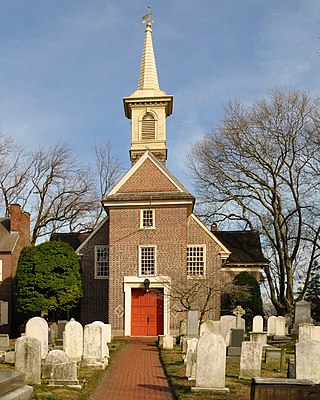
The architecture of Philadelphia is a mix of historic and modern styles that reflect the city's history. The first European settlements appeared within the present day borders of Philadelphia, Pennsylvania in the 17th century with most structures being built from logs. By the 18th century, brick structures had become common. Georgian and later Federal style buildings dominated much of the cityscape. In the first half of the 19th century, Greek revival appeared and flourished with architects such as William Strickland, John Haviland, and Thomas U. Walter. In the second half of the 19th century, Victorian architecture became popular with the city's most notable Victorian architect being Frank Furness.

Haddington is a neighborhood in the West Philadelphia section of Philadelphia, Pennsylvania, United States. Its borders are defined as Haverford Avenue/Girard Avenue to the north, 52nd Street to the east, Market Street to the south, and 67th Street to the westernmost edge of the neighborhood.
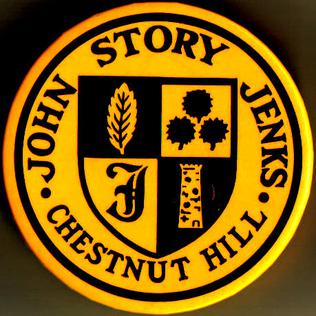
Jenks Academy for the Arts and Sciences is a public K-8 school in the Chestnut Hill section of Philadelphia, Pennsylvania, and is part of the School District of Philadelphia. Jenks serves children from kindergarten through eighth grade and has a student population of about 600. There are two classes in each grade as well as specialized programs for life skills, inclusion/learning support and gifted support. Jenks students are required to wear school uniforms.

The Centennial National Bank is a historic building in Philadelphia, Pennsylvania. Designed by noted Philadelphia architect Frank Furness and significant in his artistic development, it was built in 1876 as the headquarters of the eponymous bank that would be the fiscal agent of the Centennial Exposition. The building housed a branch of the First Pennsylvania Bank from 1956 until Drexel University purchased it c. 1976. Drexel renovated it between 2000-2002 and now uses it as an alumni center. The Centennial National Bank, described as "one of the best pieces of architecture in West Philadelphia," was placed on the National Register of Historic Places in 1971.
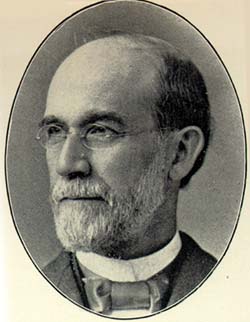
Addison Hutton (1834–1916) was a Philadelphia architect who designed prominent residences in Philadelphia and its suburbs, plus courthouses, hospitals, and libraries, including the Ridgway Library, now Philadelphia High School for the Creative and Performing Arts, and the Historical Society of Pennsylvania. He made major additions to the campuses of Westtown School, George School, Swarthmore College, Bryn Mawr College, Haverford College, and Lehigh University.

Thomas Fitzsimons Junior High School, later The Young Men's Leadership School at Thomas E. FitzSimons High School, was a public secondary school that, in its final years, was a secondary school for boys. It was located at 2601 West Cumberland Street in Philadelphia, Pennsylvania, United States and was a part of the School District of Philadelphia. The school was named after Thomas FitzSimons, who was a signer of the Constitution of the United States.

The United States Custom House is a historic United States federal government building in Philadelphia, Pennsylvania. Built between 1932 and 1934 to the Art Deco designs of the architectural firm of Ritter & Shay, the building occupies an entire block between Second, Chestnut, and Sansom Streets and the former Exchange Place in the heart of the oldest section of the city. Its south and west sides border Independence National Historical Park.

The Awbury Historic District is a historic area in the East Germantown neighborhood of Philadelphia, Pennsylvania. It encompasses the former summer homes and farms of the extended Cope family, who moved to the area starting in 1849 and the entire Awbury Arboretum, which occupies most of the district's area, as well as adjacent properties developed and occupied by Henry Cope (1793-1865), son and successor to prominent Philadelphia Orthodox Quaker merchant Thomas Pym Cope (1768-1854), his close relatives, and his descendants. The district, which has been described by Philadelphia area historians as "visually distinct from the densely-built urban blocks that surround it on three sides, and from the level, open landscape of the city park to the northwest," features buildings which were designed in the Gothic Revival, Italian Villa, Queen Anne, Tudor Revival, Shingle, and Colonial Revival styles of architecture between 1849 and 1922.
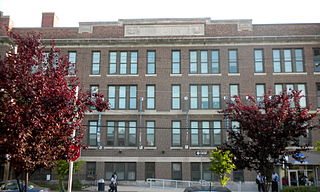
Mastery Charter School Thomas Campus, formerly the George C. Thomas Junior High School, is a secondary charter school located in the south section of Philadelphia, Pennsylvania. It is run by Mastery Charter Schools. It is located at the intersection of 9th and Johnston Streets just north of the South Philadelphia Sports Complex. Nearby are the residential neighborhoods of Marconi Plaza, Lower Moyamensing, and Packer Park; the recreational parkland of FDR Park; and the historical and new business-development center of the Philadelphia Naval Shipyard. The school is located within the boundaries of the Sports Complex Special Services District, directly on the Oregon Avenue urban corridor of small shops and restaurants anchored by larger shopping plazas on the east and west end of Oregon Avenue, and near the revitalized commercial area of Passyunk Avenue. It shares a site with the D. Newlin Fell School.
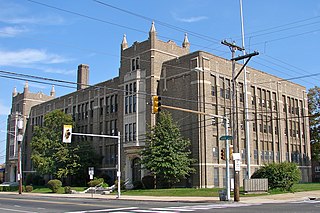
The Universal Creighton Charter School is a historic school that is located in the Crescentville neighborhood of Philadelphia, Pennsylvania, United States.
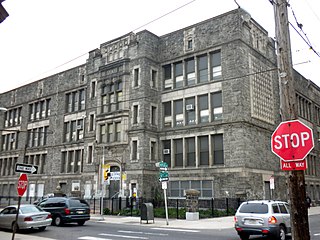
Southwark School is a public K-8 school located in the Central South Philadelphia neighborhood of Philadelphia, Pennsylvania. It is a part of Philadelphia Public Schools.

Eliza Butler Kirkbride School is a K–8 school located in the Passyunk Square neighborhood of Philadelphia, Pennsylvania. It is a part of the School District of Philadelphia.

The Universal Vare Charter School, formerly the Edwin H. Vare Junior High School, and Edwin H. Vare Middle School, is a historic junior high school building located in the Wilson Park neighborhood of Philadelphia, Pennsylvania, United States. It is currently a charter school run by Universal Family of Schools.

Appleton Prentiss Clark Jr. was an American architect from Washington, D.C. During his 60-year career, Clark was responsible for designing hundreds of buildings in the Washington area, including homes, hotels, churches, apartments and commercial properties. He is considered one of the city's most prominent and influential architects from the late 19th and early 20th centuries. Many of his designs are now listed on the National Register of Historic Places (NRHP).
David Oliver Whilldin was an American architect in Alabama. Several of the buildings he designed are listed on the National Register of Historic Places, including his office building the Whilldin Building. His designs include Legion Field and schools in the Birmingham City Schools district.






















